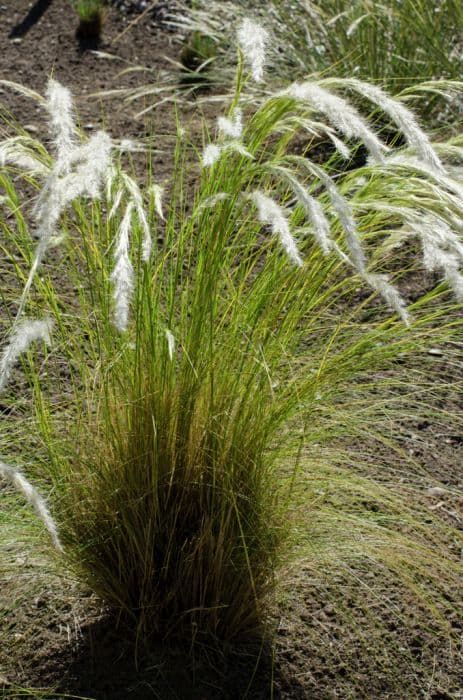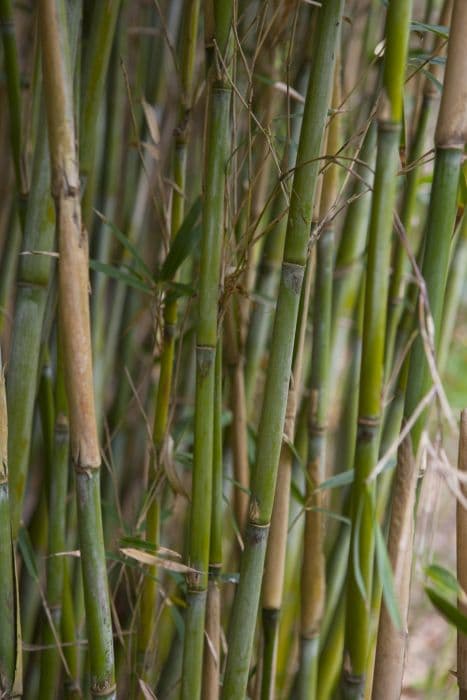Peruvian Feather Grass Stipa ichu

ABOUT
The Stipa ichu, commonly known as Peruvian feather grass, is a perennial grass displaying a clump-forming growth habit. Its appearance is characterized by fine, needle-like foliage that forms dense tussocks or mounds. The leaves exhibit a light green to bluish-green color, providing a delicate and feathery texture to the landscape where it grows. During the blooming season, Peruvian feather grass produces airy, graceful flower spikes. The flowers are usually a silvery or golden color, waving atop slender stems and contributing to the plant's overall wispy and elegant look. These flowering stems can sway gracefully in the wind, adding movement and interest to gardens or natural grassy settings. In colder seasons or less than ideal conditions, the foliage may turn to a straw-like hue, which still retains a visual appeal through the winter months.
About this plant
 Names
NamesSynonyms
Peruvian Feather Grass, Andean Feather Grass, Ichu, Paja Brava, Paja Ichu.
Common names
Stipa ichu var. aristulata, Stipa tenacissima var. ichu, Jarava ichu, Stipa papposa.
 Toxicity
ToxicityTo humans
The plant known as Peruvian feather grass is not commonly recognized for being toxic to humans. There is limited information on the toxicity of Peruvian feather grass if ingested. However, as with many plants, it is advisable to refrain from eating it due to the potential for individual allergic reactions or irritation. Always exercise caution and consult a healthcare professional or a poison control center if any part of the plant is ingested and symptoms or adverse reactions occur.
To pets
Peruvian feather grass is not commonly known to be toxic to pets either. However, the lack of toxicity does not mean it is safe for pets to consume. Grasses can lead to digestive issues such as blockages or irritation in animals, particularly if ingested in large quantities. If a pet ingests this plant and displays symptoms such as vomiting, diarrhea, or lethargy, it is important to seek veterinary care. Always be cautious with plants around pets and consult with a veterinarian if there are any concerns about ingestion or poisoning.
 Characteristics
CharacteristicsLife cycle
Perennials
Foliage type
Evergreen
Color of leaves
Green
Height
2 feet [0.6 meters]
Spread
2 feet [0.6 meters]
Plant type
Herb
Hardiness zones
7
Native area
South America
Benefits
 General Benefits
General Benefits- Erosion Control: Stipa ichu has deep roots that help stabilize soil and prevent erosion, making it valuable for slope stabilization and land rehabilitation.
- Forage for Livestock: It serves as a source of forage for grazing animals such as sheep and cattle, especially in the Andean region where it is native.
- Ornamental Use: Due to its feather-like plumes and graceful appearance, it is often used in landscaping and garden designs for aesthetic purposes.
- Ecosystem Support: The plant provides habitat for wildlife, supporting biodiversity as it is part of the natural grassland ecosystems.
- Cultural Significance: Known as "ichu," it has been used by indigenous peoples for various purposes, including traditional thatching for roofs and as ceremonial offerings.
- Low Maintenance: Stipa ichu is adapted to harsh conditions and requires minimal care once established, making it suitable for low-water-use gardens or xeriscaping.
 Medical Properties
Medical PropertiesThis plant is not used for medical purposes.
 Air-purifying Qualities
Air-purifying QualitiesThis plant is not specifically known for air purifying qualities.
 Other Uses
Other Uses- Stipa ichu, commonly known as Peruvian feathergrass, can be utilized in musical instrument construction, particularly in the making of traditional Andean flutes where the grass stems serve as structural components.
- The grass is sometimes incorporated into artisanal jewelry, where dried stems are fashioned into beads or used as decorative accents.
- Peruvian feathergrass is used in landscape design for erosion control on slopes and banks due to its deep root system that helps stabilize soil.
- In textile arts, the fibrous material from the grass can be woven to create mats, baskets, and even hats in rural communities.
- Peruvian feathergrass is commonly used as packing material for transporting fragile items in South America, taking advantage of its cushioning properties.
- The grass serves as an ecological indicator of soil health and nutrient levels, helping farmers make decisions about land management practices.
- It's used in the reclamation of degraded lands, such as former mining sites, where it plays a role in rebuilding the soil structure and fostering a suitable environment for other plants to grow.
- In some areas, the dried grass is used as fuel for fires, providing a sustainable alternative to wood in rural communities.
- The seeds of Peruvian feathergrass are occasionally used in craft activities for children, such as making homemade bird feeders.
- The natural resilience and hardiness of the grass make it an ideal choice for creating windbreaks and barriers against dust storms in arid regions.
Interesting Facts
 Feng Shui
Feng ShuiThe Peruvian feather grass is not used in Feng Shui practice.
 Zodiac Sign Compitability
Zodiac Sign CompitabilityThe Peruvian feather grass is not used in astrology practice.
 Plant Symbolism
Plant Symbolism- Resilience: Stipa ichu, also known as Peruvian Feather Grass, thrives in harsh, arid environments, symbolizing the ability to endure and persist through difficult conditions.
- Simplicity: Its slender, minimalist appearance represents a beauty in simplicity, reminding us of the elegance in the unadorned and natural state of things.
- Elegance: The feather-like plumes and graceful sway of Peruvian Feather Grass convey a sense of sophistication and refined beauty, often associated with an elegant demeanor.
- Adaptability: As a plant that can adapt to tough terrains, Peruvian Feather Grass suggests the power of adaptability and finding ways to flourish regardless of the circumstances.
 Water
WaterPeruvian feather grass, or Stipa ichu, should be watered deeply but infrequently, allowing the soil to dry out between waterings to mimic its native arid conditions. Typically, providing about 1.5 gallons every two weeks during the growing season is adequate; however, this can be adjusted depending on the climate and soil type – more water may be needed in extremely hot or windy climates, or with sandy soils that drain quickly. Ensure a thorough soak so that the water reaches the deep roots but take care not to leave the plant in standing water. In winter, water sparingly, only when the soil is completely dry, as the plant is dormant and requires much less water.
 Light
LightPeruvian feather grass thrives best in full sun conditions, receiving at least six hours of direct sunlight each day. It prefers a south-facing position if grown indoors or an unobstructed sunny spot in the garden. Sufficient light will ensure healthy growth and the characteristic feathery plumes that this grass is known for.
 Temperature
TemperaturePeruvian feather grass is hardy and adapts well to a range of temperatures, but it performs best in environments where the temperature ranges between 60°F and 75°F. The grass can survive temperatures as low as 20°F and is able to handle frosts, but prolonged exposure to conditions below this can damage the plant.
 Pruning
PruningPruning Peruvian feather grass is mainly to remove old foliage and encourage new growth. It's best to prune in late winter or early spring, cutting back the grass to about 6 inches from ground level. This timing allows the plant to regenerate and produce vigorous growth as the weather warms up. Prune every year to maintain the plant’s shape and health.
 Cleaning
CleaningAs needed
 Soil
SoilPeruvian Feather Grass thrives in well-draining soil with a mix of sand, loam, and compost to mimic its natural grassland habitat. A slightly alkaline to neutral pH, around 7.0 to 7.5, suits it best.
 Repotting
RepottingPeruvian Feather Grass rarely needs repotting; it's best to do so only if it outgrows its pot or every 2-3 years to replenish soil nutrients.
 Humidity & Misting
Humidity & MistingPeruvian Feather Grass is adaptable but prefers moderate humidity levels; it does not require high humidity environments to thrive.
 Suitable locations
Suitable locationsIndoor
Grow Peruvian Feather Grass in large pots with ample sunlight.
Outdoor
Plant Peruvian Feather Grass in sunny spots with space to flourish.
Hardiness zone
7-11 USDA
 Life cycle
Life cycleStipa ichu, commonly known as Peruvian feather grass, begins its life cycle as a seed, typically germinating in the wet season when conditions are favorable. Upon germination, a root system develops, anchoring the plant and absorbing water and nutrients from the soil. The seedling grows into a mature grass, characterized by its clump-forming habit and narrow, linear leaves that are a distinguishing feature of many grass species. Peruvian feather grass then produces tall, feathery flower spikes that can catch the wind, aiding in pollination. After pollination, the flowers develop into seeds contained within spikelets, which upon maturity, are dispersed by wind, completing the cycle. This perennial grass enters a dormancy phase during adverse conditions, such as drought, only to resume growth with the return of favorable weather.
 Propogation
PropogationPropogation time
Spring to early summer
The most common method of propagating Peruvian feather grass, also known as Stipa ichu, is through seed sowing. To propagate effectively, the seeds should be sown in the spring when the soil temperature has started to warm up, usually after the last frost has passed. The seeds are lightly covered with soil and should be kept moist until germination, which typically takes about 2 to 3 weeks. The ideal soil temperature for germination is around 70°F (21°C). Once the seedlings are hardy enough, and have developed a few true leaves, they can be transplanted to their final location ensuring they are spaced adequately to accommodate the mature size of the grass tufts. It's important to note that, like most grasses, Peruvian feather grass requires good light for germination and early growth, and doesn't tolerate soggy soil well, so well-draining soil is a must.









